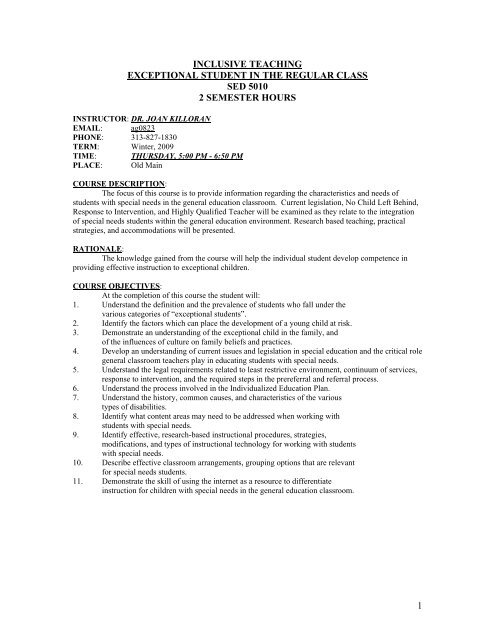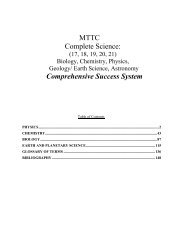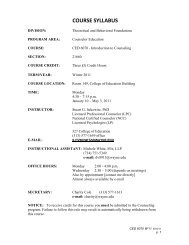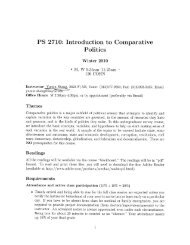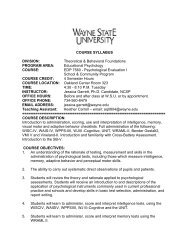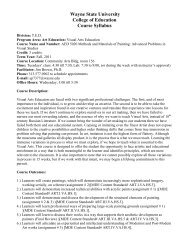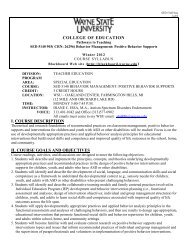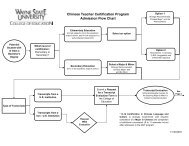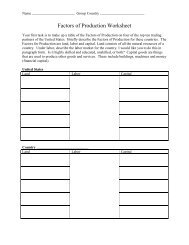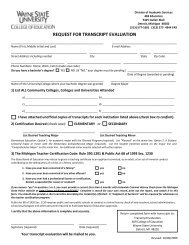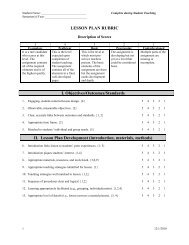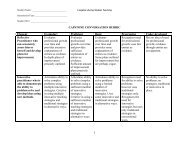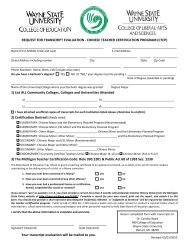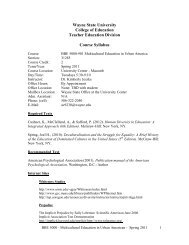SED 5010 - Wayne State University
SED 5010 - Wayne State University
SED 5010 - Wayne State University
- No tags were found...
You also want an ePaper? Increase the reach of your titles
YUMPU automatically turns print PDFs into web optimized ePapers that Google loves.
INCLUSIVE TEACHINGEXCEPTIONAL STUDENT IN THE REGULAR CLASS<strong>SED</strong> <strong>5010</strong>2 SEMESTER HOURSINSTRUCTOR: DR. JOAN KILLORANEMAIL: ag0823PHONE: 313-827-1830TERM: Winter, 2009TIME: THURSDAY, 5:00 PM - 6:50 PMPLACE: Old MainCOURSE DESCRIPTION:The focus of this course is to provide information regarding the characteristics and needs ofstudents with special needs in the general education classroom. Current legislation, No Child Left Behind,Response to Intervention, and Highly Qualified Teacher will be examined as they relate to the integrationof special needs students within the general education environment. Research based teaching, practicalstrategies, and accommodations will be presented.RATIONALE:The knowledge gained from the course will help the individual student develop competence inproviding effective instruction to exceptional children.COURSE OBJECTIVES:At the completion of this course the student will:1. Understand the definition and the prevalence of students who fall under thevarious categories of “exceptional students”.2. Identify the factors which can place the development of a young child at risk.3. Demonstrate an understanding of the exceptional child in the family, andof the influences of culture on family beliefs and practices.4. Develop an understanding of current issues and legislation in special education and the critical rolegeneral classroom teachers play in educating students with special needs.5. Understand the legal requirements related to least restrictive environment, continuum of services,response to intervention, and the required steps in the prereferral and referral process.6. Understand the process involved in the Individualized Education Plan.7. Understand the history, common causes, and characteristics of the varioustypes of disabilities.8. Identify what content areas may need to be addressed when working withstudents with special needs.9. Identify effective, research-based instructional procedures, strategies,modifications, and types of instructional technology for working with studentswith special needs.10. Describe effective classroom arrangements, grouping options that are relevantfor special needs students.11. Demonstrate the skill of using the internet as a resource to differentiateinstruction for children with special needs in the general education classroom.1
COURSE TEXTBOOK:Taylor, R., Smiley, L., & Richards, S. (2009). Exceptional Students - Preparing Teachers forthe 21 st Century. New York: McGraw Hill. (Required Text)Each chapter will begin with a case study about a student with special needs. Throughout thechapter that case study will be revisited to give you an opportunity to apply the key concepts. The secondhalf of each chapter is organized for the general education teacher around planning and implementinginstruction for the special needs students within the general education classroom. The main areas that areaddressed are:-instructional content,-instructional procedures,-instructional environment, and-instructional technology. (Taylor, xv)Go to the Companion Website for the required text, www.mhhe.com/taylor1e to access studyresources, Web links, practice quizzes, and extending materials.OPTIONAL READINGS:Friend & Bursuck. (2005). Including Students with Special Needs. (4 th ed.). Boston: Allyn andBacon.Mastropieri, M. & Scruggs, T. (2004). The Inclusive Classroom - Strategies for EffectiveEducation (2 nd ed.). Columbus, Ohio: Merrill Prentice Hall.Rief, S. & Heimburge, J. (1996). How to Reach and Teach All Students in the InclusiveClassroom - Ready to Use Strategies, Lessons, and Activities for Teaching Students with Diverse LearningNeeds. West Nyack, NY: The Center for Applied Research in Education.REFERENCES:Asperger’s Syndrome: http://www/wpi.edu/~trek/aspergers.htmlAutism Society of America: http://www.autism-society.orgAttention Deficit Disorder: http://www.enteract.com/~peregrin/add/50clas.htmlhttp://www.additudemag.comNational Associaltion for Down Syndrome: http://www.nads.orgDyslexia: http://www.dyslexiacenter.comCouncil for Exceptional Children: http://www.cec.sped.orgLearning Disabilities: http://www.ldonline.orgCOURSE REQUIREMENTS:Study Guide: (250 points)The study guide is included at the end of this syllabus. It is a take home assignment which is to becompleted throughout the course. You will be required to turn in completed chapters three times during thecourse. Follow the time line for dates when the chapters are due. The study guide includes readings fromthe textbook, questions, case studies, and internet assignments. The study guide is to be completedindividually.Exam I: (50 points)Exam II: (100 points)Exam III: (100 points)Exams will be based on lectures, handouts, notes, textbook, study guide,internet assignments, class discussions, etc.The content of the exams are not limited to text, study guide, handouts, and lectures. There will be multiplechoice and short essay questions that require the ability to apply the learned material to different situations.The expectation is that you have the ability to generalize the learned information to the content area /grade level you teach or desire to teach.2
ATTENDANCE:Required. It is the student’s responsibility to sign in each week. Lectures are a major part of theexams. Therefore, lack of attendance could greatly affect your exam grades and final grade.COURSE EXPECTATIONS:In additions to completing the course requirements, students are expected to:1. Attend each class session (5:00-6:50 pm) and actively participate in classdiscussions and small group activities.2. Submit assignments on time. Points will be deducted for late assignments.There will be no incompletes given at the end of the course. “0” points will begiven for all assignments and exams not submitted by the last session. You may turnassignments in early.3. Take all exams as scheduled.4. Type all assignments. (Single space).5. Follow the guidelines for references provided in the Publication Manual of theAmerican Psychological Association.6. Read assigned materials and participate in class discussions.7. Email the Professor if you will be absent from class.8. You are responsible for missed notes and handouts. Exchange your name and phone numberwith a classmate. Notify that classmate if you will be absent so that person can collect handouts foryou.9. Handouts are not available after the night they are passed out from the instructor.You need to have someone collect the handouts for you or make a copy of someone’sif you are absent. Lectures, handouts, group activities, and textbook assignmentswill be represented on the exams.10. If you are absent the day of a test or an assignment is due, points will be deductedfrom the test and/or assignment, even if it is an excused absence.11. Turn off all phones, pagers, tape recorders, etc. before the start of class.12. Withdrawal Policy: Students who withdraw from a course after the end of the 4 thweek of class will receive a grade of WP, WF, or WN.-WP will be awarded if the student is passing the course (based on work due to date)at the time the withdrawal is requested.-WF will be awarded if the student is failing the course (based on work due to date)at the time the withdrawal is requested.-WN will be awarded if no materials have been submitted, and so there is no basisfor a grade.UNIVERSITY POLICY:TO ALL STUDENTS REGARDING ACADEMIC DISHONESTY AND PLAGIARISM: TheCollege of Education has “zero tolerance” approach to plagiarism and other forms of academic dishonesty.Specific examples of academic dishonesty, including what constitutes plagiarism, can be found in the<strong>University</strong>’s Undergraduate Bulletin, the Undergraduate Student Handbook, and the Student Due ProcessPolicy. It is each student’s responsibility to read these documents to be aware which actions are defined asacademic dishonesty. Sanctions include failure in the course involved, probation, and expulsion. Studentsare advised to think carefully and thoroughly, ask for help from instructors if it is needed, and to makesmart decisions about their academic work.ATTENTION STUDENTS WITH DISABILITIES: <strong>Wayne</strong> <strong>State</strong> <strong>University</strong> and the College ofEducation are committed to providing students with disabilities an equal opportunity to benefit from itsprograms, services, and activities. All printed materials are available in alternative formats. Please requestalternative format materials from the course instructor. If the limitations imposed by your disabilityinterfere with your ability to fulfill requirements for the successful completion of this course, you arestrongly encouraged to contact Educational Accessibility Services (EAS) in the David AdamanyUndergraduate Library to request accommodation. EAS phone numbers are Voice, 313-577-1851 or TDD,313-577-33653
GRADING POINT SYSTEMStudy Guide: 250 pointsExam I: 50 pointsExam II: 100 pointsExam III: 100 pointsA 480-500 B- 420-432 D+ 366-379A- 460-479 C+ 406-419 D 352-365B+ 446-459 C 393-405 D- 340-351B 433-445 C- 380-392 E 339-BelowCollection of student assignments and exams for accreditation purposes and course samplesAssignments completed for this course may be used as evidence of candidate learning in national, regional,and state accreditation reports of COE programs. Some will be used as samples in future classes. Namesand other identifying elements of all assignments and exams will be removed before being included in anyreport or on a course site. Students who do not wish their work to be used for accreditation purposes orcourse sample must inform the instructor in writing by the end of the semester. Your participation andcooperation in the review of COE programs is appreciated. Thank you.4
INCLUSIVE TEACHINGEXCEPTIONAL STUDENT IN THE REGULAR CLASS(Topics, Sequence, Exam Dates, Due Dates, etc. may change as Instructor sees fit).Week 1&2 1/15/09 & Laws, Referral Process, MET, IEP, Read Chapters 1,2,31l22/09 Vocabulary, NCLB, RTI, High StakesTesting, Highly Qualified TeacherWeek 3&4 1/29/09 & Differential Instruction Complete Study Guide2/5/09 Types of Learners Chapters 1,2,3Week 5 2/12/09 Learning Disabilities Read Chapter 4Work on Study GuideExam I (50 points) 2/12/09 Study Guide Chapter 1,2,3 dueWeek 6 2/19/09 Learning DisabilitiesCognitive ImpairmentWeek 7&8 2/26/09 & Emotional Impairment Read Chapters 5,6,73/5/09 Behavioral Management Work on Study GuideWeek 9 3/12/09 Autism Spectrum Disorders Chapter 10, 113/19/09 WSU Spring Break - No class sessionWeek 10 3/26/09 Exam II - Study Guide II is due, Chapters 4,5,6,7Receive essay part of Exam IIIWeek 11 4/2/09 Autism Spectrum Disorders Read Chapter 11 & 14Attention Deficit/Hyperactivity Disorder Work on Study GuideWeek 12 4/9/09 Internet Research Assignment Evening Research the internet andNO CLASS THIS EVENINGwrite essay portion ofExam III.Week 13 4/16/09 Attention Deficit / Hyperactivity Disorder Read Chapter 14Essay for Exam III is due.Work on Study GuideWeek 14 3/23/09 Exam III (100 points) Study Guide Chapters10,11,14 Due5
INCLUSIVE TEACHINGEXCEPTIONAL STUDENT IN THE REGULAR CLASSRUBRIC FOR ASSIGNMENTSPoints based on the following three areas:-ACCURACY AND UNDERSTANDING OF CONTENT-APPLICATION AND CRITICAL THINKING-FORMAT AND COMPLETION OF ASSIGNMENTACCURACY AND UNDERSTANDING OF CONTENTPROFICIENT: The student shows proficient understanding of the presented issues by thoroughlyand correctly:-addressing the relevant content,-substantiating points with several accurate examples,-identifying and addressing the key concepts, and-extensively using correct terminology.MINIMAL: The student shows minimal understanding of the presented issues by:-barely touching on the relevant content,-poorly or incorrectly identifying and addressing a key concept,-not substantiating points with relevant or accurate examples, and-limited or not using correct terminology.UNSATISFACTORY: The student shows no understanding of the presented issues by:-not addressing or incorrectly addressing the relevant content,-not identifying or addressing a key concept,-providing irrelevant or inaccurate unsubstantiated examples, and-incorrectly or not using correct terminology.APPLICATION AND CRITICAL THINKINGPROFICIENT: The student demonstrates application and critical thinking skills:-accurately identifies the problem / question and provides a well developed summary,-accurately identifies conclusions, implications, and consequences with a well-definedexplanation,-provides an objective reflection of own assertions,-develops an appropriate solution to a given scenario,-supports the solution with facts and details, and-demonstrates unique self-expression.MINIMAL: The student demonstrates minimal application and critical thinking skills:-identifies the problem / question and provides a limited summary or identifies aninappropriate problem / question,-provides limited explanation, inaccurate, or merely provides a list of ideas ordiscusses only one area when several should be addressed,-develops an inappropriate solution that is not workable,-important details are excluded, and-limited self-expression.UNSATISFACTORY: The student does not demonstrate application and critical thinking skills:-does not identify or summarize the problem / question accurately, if at all,-does not identify or evaluate any conclusions, implications, or consequences,-does not provide a solution, and-only the problem is addressed.6
FORMAT AND COMPLETION OF ASSIGNMENTPROFICIENT: The student demonstrates proficient work when:-assignment follows designated guidelines,-references are formatted correctly,-assignment is turned in before the due date or on due date, and-questions are answered well and reflect mature and consistent effort.MINIMAL: The student demonstrates minimal work when:-assignment lacks many elements of correct formatting,-references are not formatted correctly,-assignment is turned in late, and-assignment does not answer the questions and does not reflect effort.UNSATISFACTORY: The student demonstrates unsatisfactory work when:-assignment does not follow correct formatting,-references are not cited, and/or-assignment is not turned in.ASSIGNMENT TOTAL PROFICIENT MINIMAL UNSATISFACTORYChapter 1-3 63 49-63 39-48 0-38Chapter 4-7 108 88-108 60-87 0-59Chapter 10,11,14 79 63-79 32-62 0-31Internet 50 40-50 29-39 0-287
STUDY GUIDEREQUIRED READING:Taylor, R., Smiley, L., & Richards, S. (2009). Exceptional Students - Preparing Teachers forthe 21 st Century. New York: McGraw-Hill.Study Guide Directions:Answers to the questions should demonstrate the use of the textbook content. The study guideprovides an opportunity to focus on relevant information from the textbook. The assignment is to becompleted independently. Answers are to be found directly in the textbook. In most cases answers will bewritten in your own words. Cite the location referred to in the text when answering the question. Example:(Taylor, p.205). Occasionally, you will need to engage in some critical thinking and application of learnedmaterial.For each question, type the question number and the question, Underline, bold, or italics thequestion so it looks different from the answer.Length of Responses:Some questions require only a listing of ideas or a brief paragraph, while others require a detailedexplanation. For items containing more than one question, be sure to answer every question within theitem. Failure to answer each part of the question will adversely affect your grade. All responses must bestated clearly and completely. Responses should be written in your own words. Be sure to cite referencesfrom the textbook when quoting or referring to the author. Example: (Taylor, p.35).Computer Generated Response:The assignment is to be printed on 8 ½ x 11 white or pastel paper. Use only black ink.SINGLE SPACE ALL RESPONSES.Grammar, Spelling, Neatness:As with any university level work, you are expected to use proper grammar and spelling in youranswers. Spell check is strongly recommended. Failure to do so will affect your grade.Materials Needed for Study Guide Assignment:Three Duo-tang folders: must have pockets and fasteners.Dividers with plastic tabs to insert the chapter titles. You will need at least 15 dividers.(Example: Chapter 4: Learning Disabilities)Final Copy:The final copy must be computer generated and fastened in a duo-tang folder. (No three ringbinders). Place labeled dividers between each chapter for easy access to a particular topic. Points will bededucted if all the papers are not attached in the duo-tang and if dividers are not labeled and insertedproperly.8
STUDY GUIDE QUESTIONSChapter One: An Overview of Special EducationGuide: page 4 # 2,page 16 # 1, 31. Reflection Topic: (5 points)Why is it important to make a distinction between a disability and a handicap?2. Reflection Topic: (5 points)If you were a parent of a child with a disability, how much would you wantto be involved in developing your child’s education program? Give examplesand reasons to support your opinion.Chapter Two: The Special Education ProcessGuide: page 61 # 2, 4, 5, 6CASE STUDY DIRECTIONSEach chapter begins with a case study describing a student with special needs in thecontext of his or her educational experience. Throughout the chapter, you are presented withrelated questions called REVISITS, which ask you to apply key concepts you have just learnedto an actual situation. These cases tie the chapter together and allow for contextual learning.You are required to answer only the Case Study Revisits that are listed in this study guide.Case Study: Sammy, page 35:3. Revisit: page 37 (3 points)4. Revisit: page 44 (3 points)5. Revisit: page 45 (3 points)6. Internet Assignment: (10 points)-Print an article from the internet about the Response to Intervention.-Write a summary of the article.-Respond to the following reflection question:As a general education teacher, why would you want to engage in thepre-referral process? Do you see any drawbacks?-Limit the summary and response to one single spaced 8 ½ x 11 paper.-Include the article with Chapter Two.7. Application: (10 points)Perform an error analysis on the following math problems from two students. Basedon the results, what would you do instructionally for each student?48 68-29 -3121 378. Application: (10 points)Write a position statement that supports the concept of the continuum of servicesmodel. Then write a position statement supporting full inclusion. Assumethat these will be presented to a group of parents of students with severedisabilities. Position statements are “I believe…”statements.Chapter Three: School, Family, and community Collaboration9. Page 84 #1 answer (3 point)Case Study: John, page 64.9
10. Revisit: Page 75 (3 points)11. Revisit: Page 80 (3 points)12. Reflection: (5 points)Which model(s) of co-teaching is/are more appealing to you? Why?Chapter Four: Students with Learning DisabilitiesGuide: Page 104 # 4, 5Page 118 # 2, 4, 5, 6, 7Page 127 # 1, 2, 3Page 129 # 1, 2, 3Case Study: Justin, page 9313. Revisit: Page 97 (3 points)14. Revisit: Page 104 (3 points)15. Revisit: Page 112 (3 points)16. Revisit : Page 118 (3 points)17. Reflection Question: (5 points)Some teachers are reluctant to provide accommodations in their classes forstudents with learning disabilities because they feel it is unfair to the otherstudents. How would you justify the need for accommodations for thereluctant educator (other than it is required by law).18. Application: (10 points)In the direct instruction approach described in this chapter, programming forgeneralization in the form of a rationale begins early in the lesson. Present threeexamples for students on why they need to learn to alphabetize.19. Internet: (10 points). Begin developing a resource guide of examples of strategies you can use in yourcurriculum area. Run off a list of strategies and include this with the study guide.This is for future reference purposes.Suggestion: Search learning disabilities - age level and/or curriculum area.Chapter Five: Students with Mental Retardation / Intellectual DisabilitiesGuide: Page 147 # 3, 4, 5Page 149 # 2Page 158 # 1, 2, 6Page 165 # 1, 2Page 169 # 1, 2, 3Case Study: Janetta, page 13520. Revisit: page 147 (3 points)21. Revisit: page 154 (3 points)22. Revisit: page 163 (3 points)23. Internet: (20 points). Look at a lesson plan that you have access to or pull one from:http://www.eduref.org/Virtual/Lessonshttp://www.lessonplanspage.comTry to choose a lesson in your curriculum area. Include the lesson plan with thestudy guide.What are some modifications in the lesson plan you might make to meetthe needs of students with mild to moderate intellectual disabilities?24. Internet: (10 points)10
Begin developing a resource guide of examples of functional curriculum andstrategies for students with mild to moderate intellectual disabilities. Includethese strategies in your study guide. Suggestion: search mental retardation,cognitive impairment, mild retardation, moderate retardation, intellectual disabilities.(This is not learning disability).Chapter Six: Students with Emotional or Behavioral DisordersGuide: Page 185 # 1, 2, 3Page 203 # 4, 5, 6Page 208 # 1, 2, 3Page 209 # 3, 4Case Study: Boddy, page 17525. Revisit: Page 185 (3 points)26. Revisit: Page 190 (3 points)27. Revisit: Page 194 (3 points)28. Revisit: Page 207 (3 points)29. Reflection: (5 points)Do you think there is any legitimacy to the concern that schools might actuallycontribute to children’s emotional or behavioral disorders? Explain youranswer.30. Reflection: (5 points)Describe the difference between externalizing and internalizing behaviors.How can we best recognize and help those with internalizing behavior problems?31. Internet: (5 points)Collect internet samples of the following to create your resource packet for thischapter to support your work with students with emotional and/or behavior issues.-Classroom rules, rewards, consequences.-Difference between emotional impairment, oppositional defiant behavior,and conduct disorder.-Classroom floor plan suggestions to help students with emotional issues.-Strategies and accommodations appropriate for those with emotional andbehavior problems.Chapter Seven: Communication DisordersGuide: Page 222 # 3, 4Page 228 # 2, 3, 4Chapter Ten: Students with Physical or Health DisabilitiesGuide: Page 326 # 3, 5Page 336 # 2, 3, 4, 5, 6, 7Page 352 # 2, 5, 6Case Studies: Marta and Ben, Page 323-32432. Revisit: Ben Page 336 (3 points)33. Revisit: Ben Page 345 (3 points)34. Revisit: Marta Page 347 (3 points)35. Reflection: (5 points)How would you address the situation if a student without a disability in your classcomplained he/she was bothered by the appearance of a student with a physicaldisability? Explain in detail.36. Internet: (8 points)-Find information on the internet that describes traumatic brain injury. Whatissues and strategies do you as a teacher need to keep in mind?11
-Add to your study guide resources to help you when working with studentswho have a physical or health problem.Chapter Eleven: Students with Autism Spectrum DisordersGuide: Page 364 # 1, 2, 3, 4, 5Page 372 # 1, 2, 3, 4, 5, 6Page 384 # 1, 2, 3, 4, 5Page 390 # 1, 2, 3, 4Page 393 # 1, 2, 3, 4, 5, 6, 7Case Study: Alex, page 35937. Revisit: Page 363 (3 points)38. Revisit: Page 372 (3 points)39. Revisit: Page 374 (3 points)40. Reflection: (8 points)What frustrations do you think parents of children with autism experience on adaily basis? Support your answer with appropriate information about autism.41. Internet: (10 points)Collect samples for the internet of the following to use with students on theautism spectrum.-visual schedules-visual activities-accommodations-strategies-behavior management-etc.Chapter 14: Students with Attention Deficit / Hyperactivity DisorderGuide: Page 485 # 1, 2, 3, 4, 5, 6Page 496 # 1, 2, 3, 4, 5Page 502 # 1, 2, 3, 4Page 505 # 1, 2, 3, 4Case Study: Andy, page 475-47642. Revisit: Page 483 (3 points)43. Revisit: Page 493 (3 points)44. Revisit: Page 502 (3 points)45. Application / Internet: (15 points)-Revisit Andy (case study in Chapter 14).-Address the grade level and /or curriculum area you are/hope to teach.-Change Andy’s age/grade to fit your level.-List Andy’s strengths and weaknesses.-Print the checklist from http://www.ldonline.org/article/5885.(Add this list to your resources in the study guide).-What accommodations / strategies would you use with Andy to:-get Andy’s attention,-focus Andy’s attention,-maintain Andy’s attention, and-keep him on task,so that Andy can be successful in your classroom?12
46. Internet: (6 points)Collect behavior management guidelines and organizational strategies to usewith students who have AD/HD. Include these in your study guide.13


